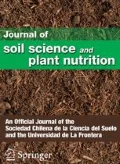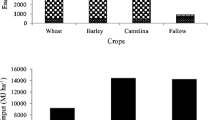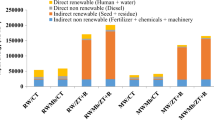Abstract
The use of energy and carbon-intensive inputs in agriculture is unsustainable as it contributes to climate change, adversely affecting crop productivity and human life. Barley, the fourth most important cereal crop, has been restricted to areas with limited resources. Maintaining a balance between productivity, profitability, and sustainability by identifying viable genotypes that adapt well to resource-restricted settings and assessing them under low energy-carbon intensive management is critical. A field experiment was conducted during 2016-17 to 2018-19 to assess the energy-carbon footprint, productivity and profitability of five barley cultivars under two contrasting tillage-residue management systems in semi-arid plains of North-West India. The zero-till + residue retention (ZT+RR) system, among the tillage-residue management options, and RD-2552 followed by BH-946, among the cultivars, provided significantly higher crop productivity and profitability. Although cultivars' responses to the tillage-residue management method were not statistically significant in terms of grain yield, they were in terms of net returns. Therefore, RD-2552 and BH-946 cultivars could provide higher profitability with the ZT+RR system as compared to those with the conventional-till + residue incorporation (CT+RI) system. Although cultivars did not affect the energy-carbon footprints of barley production, tillage-residue management methods did. The ZT+RR system enhanced the energy and carbon use efficiencies of the barley cultivation with lower energy-carbon footprints. The cultivar RD-2552 followed by BH-946 under the ZT+RR system could provide higher productivity and profitability with lower energy-carbon footprints. Adoption of conservation agriculture-based tillage-residue management practices could improve productivity and profitability of barley crop with reduced energy-carbon footprints in the semi-arid ecologies of India.
Graphical abstract








Similar content being viewed by others
Data availability
All data generated or analyzed during this study are included in this published article.
Code availability
Not applicable.
References
AOAC (1990) In K Helrich (ed) Official methods of analysis, 15th edn. Association of Official Analytical Chemists, Inc., Arlington
Ashoka P, Meena RS, Kumar S, Yadav GS, Layek J (2017) Green nanotechnology is a key for eco-friendly agriculture. J Clean Prod 142:4440–4441. https://doi.org/10.1016/j.jclepro.2016.11.117
Barut ZB, Ertekin C, Karaaga HA (2011) Tillage effects on energy use for corn silage in Mediterranean Coastal of Turkey. Energy 36:5466–5475. https://doi.org/10.1016/j.energy.2011.07.035
Busari MA, Kukal SS, Kaur A, Bhatt R, Dulazi AA (2015) Conservation tillage impacts on soil, crop and the environment. Int Soil Water Conserv Res 3:119–129. https://doi.org/10.1016/j.iswcr.2015.05.002
Chaudhary VP, Singh KK, Pratibha G, Bhattacharyya R, Shamim M, Srinivas I, Patel A (2017) Energy conservation and greenhouse gas mitigation under different production systems in rice cultivation. Energy 130:307–317. https://doi.org/10.1016/j.energy.2017.04.131
Chaudhary VP, Chandra R, Chaudhary R, Bhattacharyya R (2021) Global warming potential and energy dynamics of conservation tillage practices for different rabi crops in the Indo-Gangetic Plains. J Environ Manage 296:113–182. https://doi.org/10.1016/j.jenvman.2021.113182
Choudhary M, Rana KS, Rana DS, Bana RS (2016) Tillage and crop residue effects in rainfed pearl millet (Pennisetum glaucum) in conjunction with sulphur fertilization under pearl millet - Indian mustard (Brassica juncea) cropping system. Indian J Agron 61:15–19
Choudhary M, Rana KS, Bana RS, Ghasal PC, Choudhary GL, Jakhar P, Verma RK (2017) Energy budgeting and carbon footprint of pearl millet–mustard cropping system under conventional and conservation agriculture in rainfed semi-arid agroecosystem. Energy 141:1052–1058. https://doi.org/10.1016/j.energy.2017.09.136
Das TK, Ghosh S, Das A, Sen S, Datta D, Ghosh S, Raj R, Behera B, Roy A, Vyas AK (2021) Conservation Agriculture impacts on productivity, resource-use efficiency, and environmental sustainability: A holistic review. Indian J Agron 66:111–127
Deng JL (1985) Grey control system. Hua Zhong Institute of Technology Press, China
Devasenapathy P, Senthilkumar G, Shanmugam PM (2009) Energy management in crop production. Indian J Agron 54:80–90
Dhillon JS, Eickhoff EM, Mullen RW, Raun WR (2019) World potassium use efficiency in cereal crops. Agron J 111:889–896. https://doi.org/10.2134/agronj2018.07.0462
Dubey A, Lal R (2009) GWP and sustainability of agricultural production systems in Punjab, India, and Ohio, USA. J Crop Improv 23:332–350. https://doi.org/10.1080/15427520902969906
Faiz MA, Bana RS, Choudhary AK, Laing AM, Bansal R, Bhatia A, Bana RC, Singh YV, Kumar V, Bamboriya SD, Padaria RN, Khaswan SL, Dabas JPS (2022) Zero tillage, residue retention and system-intensification with legumes for enhanced pearl millet productivity and mineral biofortification. Sustainability 14:543. https://doi.org/10.3390/su14010543
Gan YT, Campbell CA, Jansen HH, Lemke R, Liu LP, Basnyat P, McDonald CL (2009) Carbon input to the soil by oilseed and pulse crops in a semiarid environment. Agric Ecosyst Environ 132:290–297. https://doi.org/10.1016/j.agee.2009.04.014
Ghorbani R, Mondani F, Amirmoradi S, Feizi H, Khorramdel S, Teimouri M, Sanjani S, Anvarkhah S, Aghel H (2011) A case study of energy use and economical analysis of irrigated and dryland wheat production systems. Appl Energy 88:283–288. https://doi.org/10.1016/j.apenergy.2010.04.028
Goglio P, Grant BB, Smith WN, Desjardins RL, Worth DE, Zentner R, Malhi SS (2014) Impact of management strategies on the global warming potential at the cropping system level. Sci Total Environ 490:921–933. https://doi.org/10.1016/j.scitotenv.2014.05.070
Hanway JJ, Heidel H (1952) Soil analysis methods as used in Iowa state college soil testing laboratory. Iowa Agric 57:1–31
Hosseini SZ, Firouzi S, Aminpanah H, Sadeghnejhad HR (2016) Effect of tillage system on yield and weed populations of soybean (Glycine max L.). An Acad Bras Ciênc 88:377–384. https://doi.org/10.1590/00013765201620140590
Indian Council of Medical Research (1981) Recommended dietary intakes for Indians. National Institute of Nutrition, ICMR, Hyderabad, p 87
Kirschbaum MU (2014) Climate-change impact potentials as an alternative to global warming potentials. Environ Res Lett 9:1–11. https://doi.org/10.1088/17489326/9/3/034014
Krupnik TJ, Shennan C, Rodenburg J (2012) Yield, water productivity and nutrient balances under the system of rice intensification and recommended management practices in the Sahel. Field Crops Res 130:155–167. https://doi.org/10.1016/j.fcr.2012.02.003
Kumar V, Khippal A, Singh J, Selvakumar R, Malik R et al (2014) Barley research in India: Retrospect & prospects. J Wheat Res 6:1–20
Kushwaha CP, Singh KP (2005) Crop productivity and soil fertility in a tropical dryland agro-ecosystem: impact of residue and tillage management. Exp Agric 41:39–50. https://doi.org/10.1017/S0014479704002303Liu
Lal R (2004) Carbon emission from farm operations. Environ Inter 30:981–990. https://doi.org/10.1016/j.envint.2004.03.005
Lal R (2015) Sequestering carbon and increasing productivity by conservation agriculture. J Soil Water Conserv 70:55A–62A. https://doi.org/10.2489/jswc.70.3.55A
Lal B, Gautam P, Nayak AK, Panda BB, Bihari P, Tripathi R et al (2019) Energy and carbon budgeting of tillage for environmentally clean and resilient soil health of rice-maize cropping system. J Clean Prod 226:815–830. https://doi.org/10.1016/j.jclepro.2019.04.041
Lindner RC (1944) Rapid analytical methods for some of the more common inorganic constituents of the plant tissues. Plant Physiol 19:76–89. https://doi.org/10.1104/pp.19.1.76
Liu Q, Liu B, Ambus P, Zhang Y, Hansen V, Lin Z, Shen D, Liu G, Bei Q, Zhu J, Wang X (2016) Carbon footprint of rice production under biochar amendment–a case study in a Chinese rice cropping system. GCB Bioenergy 8:148–159. https://doi.org/10.1111/gcbb.12248
Lobell DB, Gourdji SM (2012) The influence of climate change on global crop productivity. Plant Physiol 160:1686–1697. https://doi.org/10.1104/pp.112.208298
Meena RS, Kumar V, Yadav GS, Mitran T (2018) Response and interaction of Bradyrhizobium japonicum and Arbuscular mycorrhizal fungi in the soybean rhizosphere: A review. Plant Growth Regul 84:207–223. https://doi.org/10.1007/s1072501703348
Meena OP, Sammauria R, Gupta AK, Gupta KC, Behera B et al (2022) Energy-carbon footprint vis-à-vis system productivity and profitability of diversified crop rotations in semi-arid plains of North-West India. J Plant Nutr Soil Sci 22:2026–2041. https://doi.org/10.1007/s42729-022-00791-2
Mittal JP, Dhawan KC (1988) Research manual on energy requirements in agricultural sector. ICAR, New Delhi, pp 20–23
Mohammadi A, Rafiee S, Jafari A, Keyhani A, Mousavi-Avval SH, Nonhebel S (2014) Energy use efficiency and greenhouse gas emissions of farming systems in north Iran. Renew Sustain Energy Rev 30:724–733. https://doi.org/10.1016/j.rser.2013.11.012
Mrunalini K, Rolaniya LK, Datta D, Kumar S, Behera B, Makarana G, Singh A, Prasad JVNS, Pratibha GS, Naik MR, Swamy GN, Rao CS (2020) Resource conservation technologies for climate change adaptation and mitigation. In: Rao CS (ed) Climate Change and Indian Agriculture: Challenges and Adaptation Strategies. ICAR-National Academy of Agricultural Research Management, Hyderabad, Telangana, India, pp 1–22
Ntinas GK, Neumair M, Tsadilas CD, Meyer J (2017) Carbon footprint and cumulative energy demand of greenhouse and open-field tomato cultivation systems under Southern and Central European climatic conditions. J Clean Prod 142:3617–3626. https://doi.org/10.1016/j.jclepro.2016.10.106
Olsen BC, Cole CV, Watenabe FS, Dean LA (1954) Estimation of available phosphorus by extraction with sodium carbonate. USDA, Circular No. 939:19
Ozkan B, Akcaoz H, Fert C (2004) Energy input-output analysis in Turkish agriculture. Renew Energy 29:39–51. https://doi.org/10.1016/S09601481(03)00135-6
Ozpinar S, Ozpinar A (2011) Influence of tillage and crop rotation systems on economy and weed density in a semi-arid region. J Agric Sci Technol 13:769–784
Pandey D, Agrawal M (2014) Carbon footprint estimation in the agriculture sector. In: Assessment of carbon footprint in different industrial sectors, vol 1. Springer, Singapore, pp 25–47. https://doi.org/10.1007/9789814560412_2
Parihar CM, Jat SL, Singh AK, Majumdar K, Jat ML, Saharawat YS, Pradhan S, Kuri BR (2017) Bio-energy, water-use efficiency and economics of maize-wheat mungbean system under precision-conservation agriculture in semi-arid agroecosystem. Energy 119:245–256. https://doi.org/10.1016/j.energy.2016.12.068
Parihar CM, Jat SL, Singh AK, Kumar B, Rathore NS, Jat ML, Saharawat YS, Kuri BR (2018) Energy auditing of long-term conservation agriculture based irrigated intensive maize systems in semi-arid tropics of India. Energy 142:289–302. https://doi.org/10.1016/j.energy.2017.10.015
Patil SB, Balakrishna Reddy BC, Chitgupekar SC, Patil BB (2015) Modern tillage and integrated nutrient management practices for improving soil fertility and productivity of groundnut (Arachis hypogaea L.) under the rainfed farming system. Int Lett Nat Sci 29:1–12. https://doi.org/10.18052/www.scipress.com/ILNS.29.1
Pratibha G, Srinivas I, Rao KV, Raju BMK, Thyagaraj CR, Korwar GR, Venkateswarlu B, Shanker AK, Choudhary DK, Rao KS, Srinivasarao C (2015) Impact of conservation agriculture practices on energy use efficiency and global warming potential in rainfed pigeon pea-castor systems. Eur J Agron 66:30–40. https://doi.org/10.1016/j.eja.2015.02.001
Rahman MM, Aravindakshan S, Hoque MA, Rahman MA, Gulandaz MA, Rahman J, Islam MT (2021) Conservation tillage (CT) for climate-smart sustainable intensification: Assessing the impact of CT on soil organic carbon accumulation, greenhouse gas emission and water footprint of wheat cultivation in Bangladesh. Environ Sustain Indic 10:100–106. https://doi.org/10.1016/j.indic.2021.100106
Roohi E, Mohammadi R, Niane AA, Niazian M, Niedbała G (2022) Agronomic performance of rainfed barley cultivars under different tillage systems in highland areas of dryland conditions. Agronomy 12:1070. https://doi.org/10.3390/agronomy12051070
Sharma R, Verma R (2010) Effect of irrigation, nitrogen and varieties on the productivity and grain malting quality in barley. Cereal Res Commun 38:419–428. https://doi.org/10.1556/crc.38.2010.3.12
Singh MK, Pal SK, Thakur R, Verma UN (1997) Energy input-output relationship of cropping systems. Indian J Agric Sci 67:262–264
Singh KP, Prakash V, Srinivas K, Srivastava AK (2008) Effect of tillage management on energy-use efficiency and economics of soybean (Glycine max) based cropping systems under the rainfed conditions in North-West Himalayan region. Soil Tillage Res 100:78–82. https://doi.org/10.1016/j.still.2008.04.011
Singh B, Sharma A, Joshi N, Mittal P, Singh S (2013) Combining ability analysis for grain yield and its components in malt barley (Hordeum vulgare). Indian J Agric Sci 83:96–98
Soni P, Taewichit C, Salokhe VM (2013) Energy consumption and CO2 emissions in rainfed agricultural production systems of Northeast Thailand. Agric Syst 116:25–36. https://doi.org/10.1016/j.agsy.2012.12.006
Subbiah BV, Asija GL (1956) A rapid procedure for the estimation of available nitrogen in soils. Curr Sci 25:259–260
Tjandra TB, Ng R, Yeo Z, Song B (2016) Framework and methods to quantify carbon footprint based on an office environment in Singapore. J Clean Prod 112:4183–4195. https://doi.org/10.1016/j.jclepro.2015.06.067
Tubiello FN, Cóndor-Golec RD, Salvatore M, Piersante A, Federici S, Ferrara A, Rossi S, Flammini A, Cardenas P, Biancalani R, Jacobs H, Prasula P, Prosperi P (2015) Estimating greenhouse gas emissions in agriculture: a manual to address data requirements for developing countries. Food and Agriculture Organization of the United Nation, Rome, Italy
Vourdoubas J (2016) Energy and agri-food systems: production and consumption. In: Zero waste in the Mediterranean. Natural resources, food and knowledge/International Centre for Advanced Mediterranean Agronomic Studies (CIHEAM) and Food and Agriculture Organization of the United Nations (FAO). Presses de Sciences Po, Paris, p 155
Walkley A, Black IA (1934) An examination of the Degtjareff method for determining soil organic matter, and a proposed modification of the chromic acid titration method. Soil Sci 37:29–38. https://doi.org/10.1097/0001069419340100000003
Xue JF, Pu C, Liu SL, Zhao X, Zhang R et al (2016) Carbon and nitrogen footprint of double rice production in Southern China. Ecol Indic 64:249–257. https://doi.org/10.1016/j.ecolind.2016.01.001
Yadav MR, Parihar CM, Jat SL, Singh AK, Kumar D, Pooniya V, Parihar MD, Saveipune D, Parmar H, Jat ML (2016) Effect of long-term tillage and diversified crop rotations on nutrient uptake, profitability and energetics of maize (Zea mays) in North-Western India. Indian J Agri Sci 86:743–749
Yadav GS, Lal R, Meena RS, Datta M, Babu S, Das A, Layek J, Saha P (2017) Energy budgeting for designing sustainable and environmentally clean/safer cropping systems for rainfed rice fallow lands in India. J Clean Prod 158:29–37. https://doi.org/10.1016/j.jclepro.2017.04.170
Acknowledgments
The authors are thankful to the Director, ICAR-Indian Institute of Wheat and Barley Research (ICAR-IIWBR) Karnal, Haryana, India, and the Director, Rajasthan Agricultural Research Institute (RARI), Jaipur, Rajasthan, India, for providing the necessary facilities and financial support to conduct the study.
Author information
Authors and Affiliations
Contributions
MR Yadav and S Kumar: Conceptualization, Field study, Investigation, Resource allocation, Data curation; B. Behera: Data curation, Formal analysis, Data validation, Writing of original draft; VP Yadav, AS Khrub, LR Yadav, KC Gupta, OP Meena and AS Baloda: Data analysis, Writing of original draft, Supervision; MB Raza, RK Panda, MK Lal: Review and Editing, Supervision, Graphical representation.
Corresponding author
Ethics declarations
Ethics approval
Ethical approval is not applicable.
Consent to participate
Not applicable.
Consent for publication
Not applicable.
Conflict of Interest
The authors declare that they have no known competing financial interests or personal relationships that could have appeared to influence the work reported in this paper.
Additional information
Publisher’s note
Springer Nature remains neutral with regard to jurisdictional claims in published maps and institutional affiliations.
Rights and permissions
Springer Nature or its licensor (e.g. a society or other partner) holds exclusive rights to this article under a publishing agreement with the author(s) or other rightsholder(s); author self-archiving of the accepted manuscript version of this article is solely governed by the terms of such publishing agreement and applicable law.
About this article
Cite this article
Yadav, M.R., Kumar, S., Behera, B. et al. Energy-Carbon Footprint, Productivity and Profitability of Barley Cultivars under Contrasting Tillage-Residue Managements in Semi-Arid Plains of North-West India. J Soil Sci Plant Nutr 23, 1109–1124 (2023). https://doi.org/10.1007/s42729-022-01107-0
Received:
Accepted:
Published:
Issue Date:
DOI: https://doi.org/10.1007/s42729-022-01107-0




